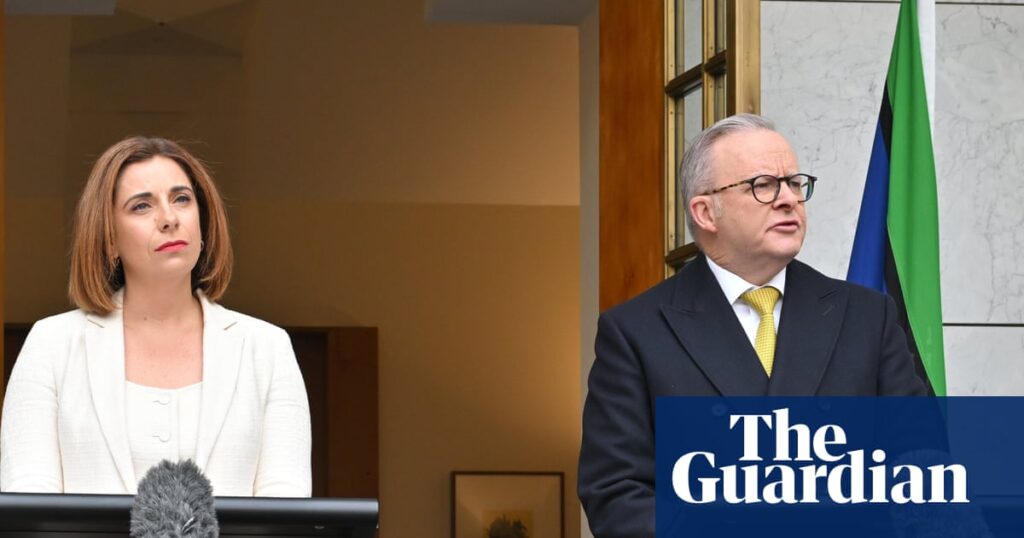Anthony Albanese admits banning children from social media “is not going to be simple”, with questions still unanswered over how tech platforms will check the ages of all Australian users – and which platforms will be included – when the government imposes its under 16s social media ban this year.
The communications minister, Anika Wells, said on Wednesday the onus will be on platforms to design simple solutions, claiming there are “lots of ways” tech companies could check the ages of their users.
The government is still waiting on results from a trial of age assurance technology, but is pressing on with plans for the ban to come into force on 10 December.
“We will not be intimidated by legal threats, when this is a genuine fight for the wellbeing of Australian kids,” Wells said on Wednesday.
Sign up: AU Breaking News email
The government announced on Wednesday it would backflip on an earlier stance and include YouTube in the under 16s social media ban after all. The Google-owned video platform had earlier been promised an exemption, but it will now join Facebook, Instagram, Snapchat, X and TikTok on the list of platforms to be banned for those under 16.
While the government named select platforms in its announcement, the rules do not specify platforms covered by the ban, but instead list factors that could see platforms excluded from the ban.
Smaller services – such as Discord, Twitch, Trump’s Truth Social or X rival Bluesky – may be required to comply.
The rules would seemingly exclude LinkedIn, which had argued to the government during the development of the legislation it was not something that was of interest to children.
From December, platforms which do not take “reasonable steps” to stop children from holding accounts on those platforms will be liable for fines up to $49.5m.
Wells said such platforms will have to deactivate existing accounts of children, ensure no new ones are established and stop any efforts to skirt those rules.
But some major tech platforms have privately raised concerns about a lack of information about what they must to do to meet the “reasonable steps” test, including what new barriers or verification methods they must add to their services. The government is expected to share more information and guidance about such steps in coming months.
Wells pushed back on the concerns of the platforms, saying the government had outlined its expectations last year when the legislation passed parliament, and that the tech companies should be engaging with the eSafety commissioner on their responses.
“Social media platforms have been on notice since December last year that this was coming. They have had 12 months to work with the eSafety Commissioner to determine what that looks like for their individual platforms,” she told a press conference in Parliament House.
“The onus here is on the platforms. Come 10 December, if your kid has a Facebook login, Facebook account, it is on Facebook to deactivate that account. It’s not on the parent to police that on behalf of Facebook.
“These are not set-and-forget rules, these are set-and-support rules. They are world-leading. But this is manifestly too important for us not to have a crack.”
YouTube last week wrote to the government, vowing to consider legal action if it was included in the ban. The company on Wednesday claimed YouTube was a video platform “not social media”.
“We share the government’s goal of addressing and reducing online harms,” a spokesperson said.
“The government’s announcement today reverses a clear, public commitment to exclude YouTube from this ban. We will consider next steps and will continue to engage with the government.”
Albanese said the government wanted to be “cooperative” but believed tech companies could implement the ban with existing information they held.
“We acknowledge that this is not going to be simple or easy … Some of this will be inevitably a work-in-progress,” he said.
“But what we know is that social media does have more information about what [a person] does than perhaps some people who are your close friends. Where you go, who you talk to, what you’re interested in, you know, they do keep that information … They can use the capacity which we know that they have.”
While the Coalition backed the social media ban, the shadow communications minister, Melissa McIntosh, accused the government of a “blatant broken promise” over including YouTube after its prior exemption.
“When the government introduced the legislation in November, they specifically excluded YouTube. This was the premise on which the legislation passed the Parliament,” she said.
“The Albanese Labor government can change a Minister, but they cannot hide the fact they deliberately misled the public,” McIntosh said.
Greens spokesperson Sarah Hanson-Young called the push “delusional”, calling for stricter rules and a duty of care for users.
“A blanket ban is simply a blunt instrument that will not make kids safer, we know that kids are going to get around it.”
Albanese will use the United Nations general assembly in September to drum up international support for Australia’s world-first social media crackdown. He said Australia would hold an event at the session in New York City, to advocate for the policy.


